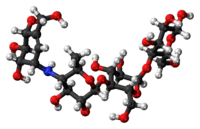Acarbose
 | |
 | |
| Clinical data | |
|---|---|
| Trade names | Glucobay, Precose |
| AHFS/Drugs.com | Monograph |
| MedlinePlus | a696015 |
| License data | |
| Pregnancy category | |
| Routes of administration | By mouth (tablets) |
| ATC code | A10BF01 (WHO) |
| Legal status | |
| Legal status | |
| Pharmacokinetic data | |
| Bioavailability | Extremely low |
| Metabolism | Gastrointestinal tract |
| Biological half-life | 2 hours |
| Excretion | Renal (less than 2%) |
| Identifiers | |
| |
| Synonyms | (2R,3R,4R,5S,6R)-5-{[(2R,3R,4R,5S,6R)-5- {[(2R,3R,4S,5S,6R)-3,4-dihydroxy-6-methyl- 5-{[(1S,4R,5S,6S)-4,5,6-trihydroxy-3- (hydroxymethyl)cyclohex-2-en-1-yl]amino} tetrahydro-2H-pyran-2-yl]oxy}-3,4-dihydroxy- 6-(hydroxymethyl)tetrahydro-2H-pyran-2-yl]oxy}- 6-(hydroxymethyl)tetrahydro-2H-pyran-2,3,4-triol |
| CAS Number |
56180-94-0 |
| PubChem (CID) | 444254 |
| IUPHAR/BPS | 6791 |
| DrugBank |
DB00284 |
| ChemSpider |
392239 |
| UNII |
T58MSI464G |
| KEGG |
D00216 |
| ChEMBL |
CHEMBL1566 |
| Chemical and physical data | |
| Formula | C25H43NO18 |
| Molar mass | 645.61 g·mol−1 |
| 3D model (Jmol) | Interactive image |
| |
| |
| (verify) | |
Acarbose (INN)[1] is an anti-diabetic drug used to treat diabetes mellitus type 2 and, in some countries, prediabetes. It is a generic sold in Europe and China as Glucobay (Bayer AG), in North America as Precose (Bayer Pharmaceuticals), and in Canada as Prandase (Bayer AG). It is cheap and popular in China, but not in the U.S. One physician explains the use in the U.S. is limited because it is not potent enough to justify the side effects of diarrhea and flatulence.[2] However, a recent large study concludes "acarbose is effective, safe and well tolerated in a large cohort of Asian patients with type 2 diabetes."[3] A possible explanation for the differing opinions is an observation that acarbose is significantly more effective in patients eating a relatively high carbohydrate Eastern diet [4]
It is a starch blocker, and inhibits alpha glucosidase, an intestinal enzyme that releases glucose from larger carbohydrates. It is composed of an acarviosin moiety with a maltose at the reducing terminus.
Mechanism of action
Acarbose inhibits enzymes (glycoside hydrolases) needed to digest carbohydrates, specifically, alpha-glucosidase enzymes in the brush border of the small intestines, and pancreatic alpha-amylase. Pancreatic alpha-amylase hydrolyzes complex starches to oligosaccharides in the lumen of the small intestine, whereas the membrane-bound intestinal alpha-glucosidases hydrolyze oligosaccharides, trisaccharides, and disaccharides to glucose and other monosaccharides in the small intestine. Inhibition of these enzyme systems reduces the rate of digestion of complex carbohydrates. Less glucose is absorbed because the carbohydrates are not broken down into glucose molecules. In diabetic patients, the short-term effect of these drugs therapies is to decrease current blood glucose levels; the long-term effect is a reduction in HbA1c level.[5] This reduction averages an absolute decrease of 0.7%, which is a decrease of about 10% in typical HbA1c values in diabetes studies.[6]
Dosing
Since acarbose prevents the digestion of complex carbohydrates, the drug should be taken at the start of main meals (taken with first bite of meal). Moreover, the amount of complex carbohydrates in the meal will determine the effectiveness of acarbose in decreasing postprandial hyperglycemia. Adults may take doses of 25 mg 3 times daily, increasing to 100 mg 3 times a day.
Side-effects
Since acarbose prevents the degradation of complex carbohydrates into glucose, some carbohydrate will remain in the intestine and be delivered to the colon. In the colon, bacteria digest the complex carbohydrates, causing gastrointestinal side-effects such as flatulence (78% of patients) and diarrhea (14% of patients). Since these effects are dose-related, in general it is advised to start with a low dose and gradually increase the dose to the desired amount. One study found that G.I. side effects decreased significantly (from 50% to 15%) over 24 weeks, even on constant dosing.[7]
If a patient using acarbose suffers from a bout of hypoglycemia, the patient must eat something containing monosaccharides, such as glucose tablets or gel (GlucoBurst, Insta-Glucose, Glutose, Level One) and a doctor should be called. Because acarbose blocks the breakdown of table sugar and other complex sugars, fruit juice or starchy foods will not effectively reverse a hypoglycemic episode in a patient taking acarbose.[8]
Hepatitis has been reported with acarbose use. It usually goes away when the medicine is stopped.[9] Therefore, liver enzymes should be checked before and during use of this medicine.
References
- ↑ "International Nonproprietary Names for Pharmaceutical Substances. Recommended International Nonproprietary Names (Rec. INN): List 19" (PDF). World Health Organization. 1979. Retrieved 9 November 2016.
- ↑ Naomi Kresge (21 November 2011). "China's Thirst for New Diabetes Drugs Threatens Bayer's Lead". Bloomberg Business Week. Archived from the original on 21 November 2011. Retrieved 15 April 2016.
- ↑ A Multinational, Observational Study to Investigate the Efficacy, Safety and Tolerability of Acarbose as Add-On or Monotherapy in a Range of Patients: The GlucoVIP Study.
- ↑ Comparison of the Hypoglycemic Effect of Acarbose Monotherapy in Patients With Type 2 Diabetes Mellitus Consuming an Eastern or Western Diet: A Systematic Meta-analysis.
- ↑ Drug Therapy in Nursing, 2nd Edition.
- ↑ "Clinical efficacy of acarbose in diabetes mellitus: a critical review of controlled trials". Diabetes Metab. 24 (4): 311–20. September 1998. PMID 9805641.
- ↑ "Efficacy of 24-week monotherapy with acarbose, metformin, or placebo in dietary-treated NIDDM patients: the Essen-II Study". Am. J. Med. 103 (6): 483–90. December 1997. doi:10.1016/S0002-9343(97)00252-0. PMID 9428831.
- ↑ "Acarbose: MedlinePlus Drug Information
- ↑ http://apps.who.int/medicinedocs/en/d/Js2268e/2.html#Js2268e.2.1
External links
- Precose (acarbose) Tablet - NIH Information (Bayer HealthCare Pharmaceuticals)
- "Probing the Pancreas" - by Craig D. Reid, Ph.D. (US FDA Consumer Article)